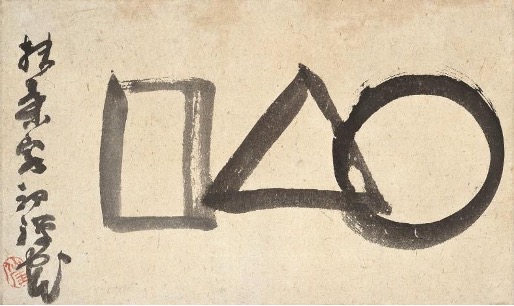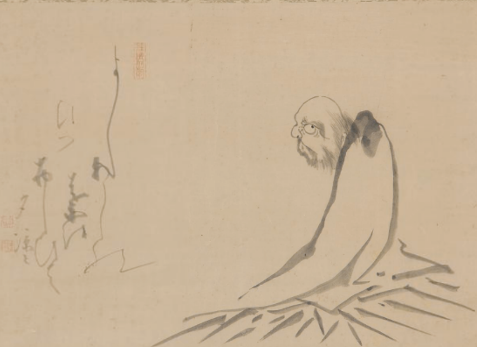

‘What is the sound of one hand clapping?’ - Hakuin Ekaku (1686 – 1769)
This famous kōan, a paradoxical question, was the favourite riddle of the Zen master Ekaku. By asking it he tested his students, provoking them to abandon typical human logic as a way to achieve spiritual awakening - satori.
Zen came to Japan via China as a reaction to the teachings of the traditional Buddhist sects, overgrown with layers of complex theology and ritual pageantry, popular with the upper classes of society. In the 6th century, an Indian monk Bodhidharma (Daruma) introduced a new, meditational approach to Buddhism on Japanese soil. Here, infused with the Taoist, Neo-Confucianism and Shinto influences, it produced a unique school of thought highlighting the importance of personal effort (jiriki) and spiritual discipline on the journey to satori through a direct relationship between the pupil and master, rather than dependence on the mediation of myriads of redemptory deities. This angle resonated with wider circles of Japanese society, the samurai class in particular.
Daishin Gito (1657 – 1730), Edo period, 17th / 18th Century, Three Jewels of Buddhism, ink on paper, inscribed, sealed and signed, 32cm high, 50cm long, from an English private collection of Zen paintings, ex collection of Daikokuji temple. Lot 315 in Asian Art I estimate of £400 - £600
Zen is a reminder that in truth the teachings of Buddha are simple. The aesthetic movement derived from this thought finds beauty in an everyday object, its imperfections, the wabi, and can be applied to all aspects of art and life, from pottery to architecture. Zen paintings, Zenga, are chiefly inspired by the Chinese literati ink paintings of the Song and Yuan Dynasties, as well as the spontaneous style of the 13th-century Hangzhou monks. Conceptually zenga strips the distracting details and cuts through the unnecessary noise of the world to confront the viewer directly the true nature of the subject, reverting to the spiritual experience as the core of experiencing beauty. The object depicted through the simple medium of monochrome ink is meant only as a symbol of itself. The accompanying poem or a short text is merely aiding the internal journey to Enlightenment. A true Zenga encourages us to look WITHIN whilst admiring the painting in front of us. As Buddha himself said, if we look at the finger pointing at the moon we have already missed the point of the spiritual exercise.
Sengai Gibon (1750 – 1837), Village Hut Edo period, circa 1800, ink on paper, sealed and signed 56cm high, 24cm long, from an English private collection of Zenga. Lot 313 in Asian Art I, with an estimate of £500 -£700.
Relying upon a finger, we see the moon
Relying upon the moon, we understand the finger.
Moon and finger
Are neither the same nor different.
This expedient analogy is for guiding beginners.
Having seen reality as it is,
There is neither moon nor a finger.
Ryōkan Taigu (1758 – 1831)
Despite the visual simplicity, the spiritual aspect of Zenga should not be forgotten. The group of paintings presented in the May sale lists several prominent Zenga artists, nearly all of whom were monks and abbots from important temples, the majority associated with the Rinzai Zen sect. Daishin Gito (1657 – 1730) was a high-ranking Rinzai priest, the 273rd abbot of Daitokuji Temple in Kyoto. The scroll featured in the May sale has been inscribed on the exterior Daishin Osho hitsu, Daitokuji ni shichi san sei, chakake (painted by priest Osho, Daitoku temple, no 273, for tea ceremony). Sengai Gibon (1750 – 1837), the 123rd abbot of Shōfukuji Temple was renowned for his controversial teachings as much as his light-hearted ink paintings, often full of self-deprecating humour. He never considered his own works as serious art and was said to paint for anyone who requested it. Gibon spent his retirement receiving guests, painting and teaching. His most recognisable work, The Universe from circa 1800, is a simple depiction of an overlapping square, a circle and a triangle.

Sengai Gibon (1750 – 1837), The Universe, Smithsonian's National Museum of Asian Art, accession no S2012.9.4606
Coming from such a close-knit environment, many of these monk artists knew each other and each other’s works, having direct access to the stores of the temple collections. Many studied the works by Hakuin Ekaku, including Taikan Monju, a pupil of Hakuin's student Tōrei. In his depiction of Daruma Monju relies on the old master in the subject and the chosen poem playing on the pun yoshiashi meaning both 'reeds' and 'good and evil'.
Taikan Monju (1765 - 1842), Daruma on a Reed, Edo period, 18th / 19th Century, ink on paper, inscribed, sealed and signed, 48cm high, 40cm long, from an English private collection of Zenga. Lot 314 in Asian Art I, with an estimate of £800 -£1200
.
Hakuin Ekaku (1686 – 1769), Daruma on a Reed Edo period, 18th / 19th Century, Smithsonian's National Museum of Asian Art, accession no FSC-PA-191
Nakahara Nantenbō (1839 – 1925), another follower of Ekaku and a Rinzai Zen sect master, was a prolific artist and a fervent reformer and teacher. He is seen as the one introducing Zenga to generations of modern ink painters of the 20th century.
Itinerant monks are Nantenbō's most famous motifs, examples of these compositions are found in the world's best private and museum collections of Zenga, such as the San Francisco Gitter-Yelen Collection, the Amsterdam Kaeru-An Collection, and the Smithsonian’s Museum of Modern Art, Washington D.C.
Nakahara Nantenbō (1839 – 1925), Monks Setting Out and Monks Returning, Taisho period, circa 1922, a pair of Japanese hanging scroll paintings, kakejiku, ink on paper, each signed and sealed, 5cm high, 30.5cm long, from an English private collection, acquired from Hiroshi Yanagi at Tokyo Gallery, Kyoto in the 1990s. Lot 312 in Asian Art I, with an estimate of £800 - £1200.
Since the Meiji Revolution, Zenga became avidly collected by important museums and private collections in Europe and the United States. For many collectors Zenga remains synonymous with Japanese aesthetics and philosophy and the genre is regularly exhibited worldwide. One of the most recent examples is the 2022 exhibition of pieces from the Kaeru-An Collection assembled by the Dutch physicist and artist Dr. Felix Hess in the National Museum in Prague, which includes works by both Sengai and Nantenbō.
We are excited to feature a selection of examples from these famous monk masters to form part of our 19th of May Asian Art I sale. View the full auction catalogue.
Marta Somauroo
Japanese Specialist
Asian Art Department
marta@chiswickauctions.co.uk